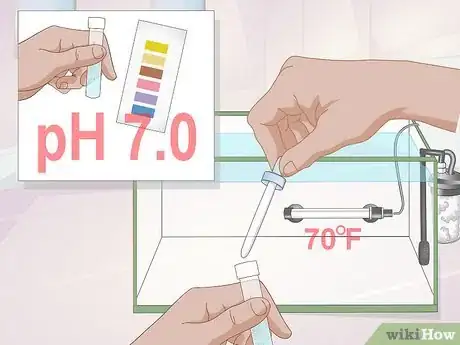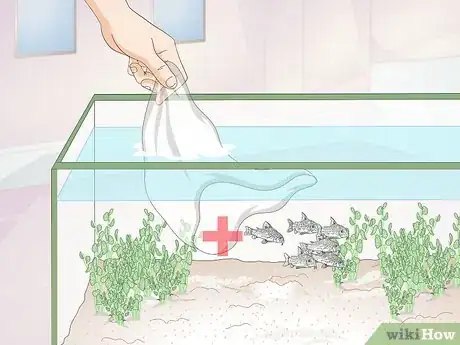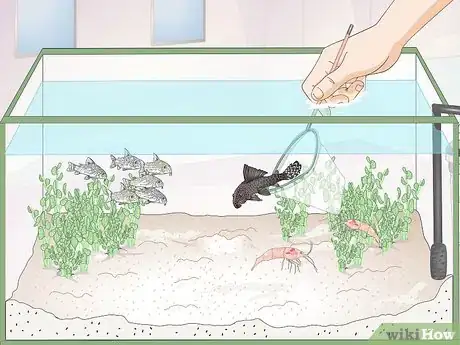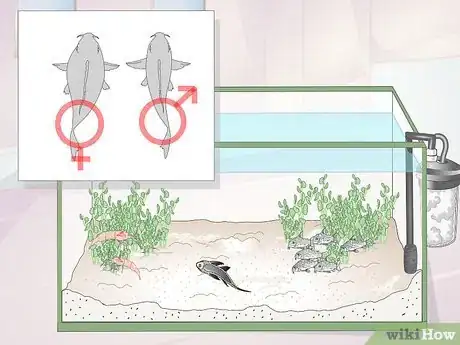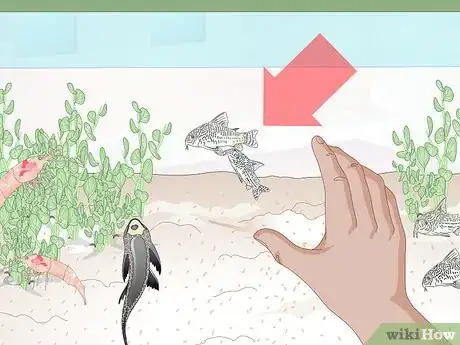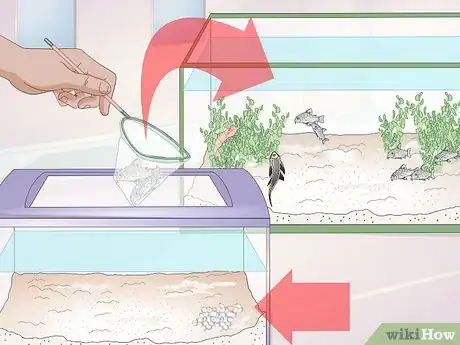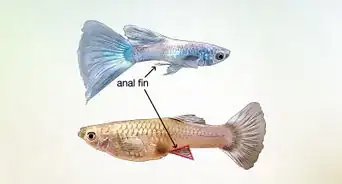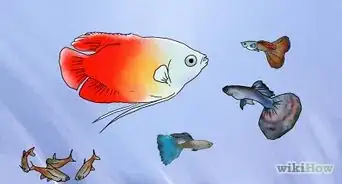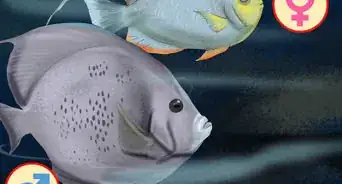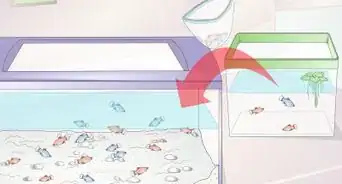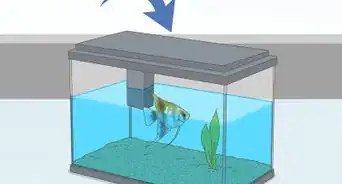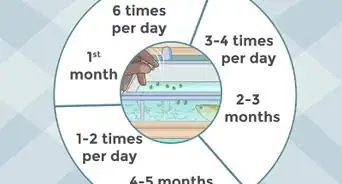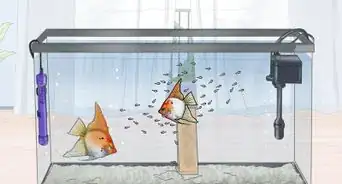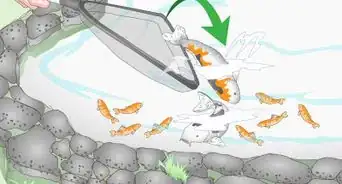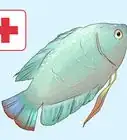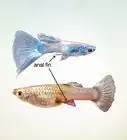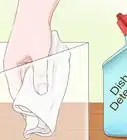This article was co-authored by Pippa Elliott, MRCVS. Dr. Elliott, BVMS, MRCVS is a veterinarian with over 30 years of experience in veterinary surgery and companion animal practice. She graduated from the University of Glasgow in 1987 with a degree in veterinary medicine and surgery. She has worked at the same animal clinic in her hometown for over 20 years.
This article has been viewed 108,364 times.
Corydoras are small fish from South America, with 180 species ranging from one to five inches long, and can be a popular addition to a personal aquarium. Although they are normally called catfish, they are not true catfish. This name comes from the barbels (whiskers) they have around their mouths. Sometimes called “Corys,” these small, sociable fish are easy to take care of, and get along well with other fish, making them a good potential addition to your tank. With the right habitat and diet, your Corydoras can thrive under your care.
Steps
Preparing the Tank
-
1Get a good-sized tank. Corydoras are not very large fish, and generally don’t need too much room. A 20-gallon tank should be plenty big enough for a small school of non-dwarf Corydoras (6 fish). Of course, if you consider adding more fish, whether Corydoras or something else, you’ll need a bigger tank.[1]
- There is a traditional “rule of thumb” that suggests 1-gallon per inch of fish that you put in the tank. This can be a good starting point for thinking about tank capacity, but keep in mind this rule is more accurate when measuring the *volume* of a fish. A ten-inch long fish probably is about 50-150 inches in volume, requiring a much larger tank than 10 1-inch-long fish that total to about 8 inches in volume. It is always best to err on the side having more space for your fish.[2]
-
2Create the right water conditions. Corydoras are hardy and adaptable fish, but they prefer certain conditions. Make sure your water’s pH level is around 7.0, and the temperature range between 70 and 78 degrees. Keep the levels of nitrites and ammonia at 0, as these toxins can cause sickness.[3]Advertisement
-
3Give the tank a smooth base. Corydoras are bottom feeders, and like to swim and explore near the bottom of the tank. To protect your fish, use very fine grain gravel or sand, with a depth of at least 2 inches. Sharp or dirty bases can damage their barbels (the whiskers near the mouth that help the fish look for food) so stick to the fine grains.[4]
- You don’t want to use small stones, as Corydoras like to dig around, and they need something sift through.
-
4Put a lot of plants into the tank. Corydoras are from areas with lots of vegetation and hiding spots, so it is important to have those in your tank. Bushy plants with lots of stems at the base are important, as well as bogwood or other decors that create areas the Corydoras can hide from other fish.
Caring for Your Fish
-
1Feed your Corydoras once a day. Corydoras are bottom-feeding catfish, so they will eat almost anything that sinks to the bottom of the tank. Provide a varied omnivorous diet of algae wafers, meaty frozen/live foods, nutritional pellets, and blanched veggies.Make sure you watch your fish eat, and avoid overfeeding by not giving them more food than they can eat in five minutes. If there is extra food in the tank, remove it to keep your tank clean.[5]
- Because Corydoras are nocturnal fish, the best time to feed them will probably be in the evening, before you turn out the lights for the night.
-
2Keep them in a school. Corydoras are social fish and generally prefer to swim in schools. For Corydoras, a school is a group of six or more. There are over a hundred different species, and you may notice that different types do not mix into one school. If you have one, it would probably enjoy some company.
- Depending on the pet store, species may or may not be sold together. Talk to the pet store about making sure you are getting the same species, and use your own eyes to compare size and color to find fish that appear to be the same.
-
3Add other fish to your tank. Corydoras are unaggressive, non-territorial fish, making them perfect community fish. One thing to consider would be to include surface and mid-level fish, which will help balance out your tank, and give people lots to look at.[6] [7]
- Good partners for your Corydoras include fish like the Otocinclus Catfish, Tetras, Swordtails, Guppies, Dwarf Cichlids, and other similar-sized fish. Filter-feeding shrimp and snails also make good company. Some of these smaller fish see Corydoras as “dither fish” (a sign that there are no predators). This will reduce fear, and help to make their transition to a new tank easier.
- Bad partners for your Corydoras include cichlids, roughens, aquarium crayfish, and fish that are larger than your Corydoras. These can injure, or even eat, your Corydoras.
Breeding Your Corydoras
-
1Check the sex of your fish. If you decide to breed your Corydoras, you of course need to know that you have both males and females. The differences are easy to notice, and you can check them by looking at your fish from above. Females will be a little larger, with a rounder and broader body, while males tend to have slightly larger pectoral fins.
- If you intend to breed your Corydoras, you should try to get a ratio of two or three males for each female.
-
2Watch for your fish to spawn. If your fish are ready to spawn, you will notice the males chasing the females and mating in the T position. Once they have mated, the female will lay her eggs against the aquarium glass, or among the leaves of the plants in your tank.
- In the wild, Corydoras usually spawn during the rainy season, so you can encourage mating by simulating these conditions. If you begin to notice your Corydoras engaging in spawning behavior, perform a water change with slightly cooler water.
-
3Separate the eggs from the parents. Once you notice eggs in the tank, you should separate them from the parents. Corydoras will eat their own and each other’s eggs, so if you want new Corydoras, you should make sure the eggs and parents are in different tanks.
- One way to do this is to move the Corydoras to a separate breeding tank when you start to notice them spawning. Once the females lay eggs in the tank, you can move the fish back into their regular tank, and let the eggs hatch in peace.
- You can also remove eggs to their own hatching and raising tank after they have been laid. Keep the water conditions as similar as possible. If the eggs were laid in the plants, you can simply transfer the plants. If you’d prefer not to remove the whole plant, it is fine to cut off the parts where the eggs are and just move that. If the eggs are on the side of the tank, remove them by rolling your finger over them. Eggs are tough, so you shouldn’t do any damage removing them this way.
-
4Feed the new fish. The eggs should hatch in three to five days. Once that happens, the new hatchlings, called “fry,” will be able to survive on their yolk sac until they start swimming freely. Once that happens, provide some brine shrimp nauplii (a type of larva) or decomposing plant material for them to eat. After about a week, you can start including microworms into their diet.
Warnings
- They need to be fed regularly just like other fish do; it is not enough for them to eat "the leftovers" or just anything on the bottom.⧼thumbs_response⧽
- If you have other fish that lay eggs on the bottom of the tank, the bottom feeders may eat the eggs.⧼thumbs_response⧽
- Be sure to follow proper fish keeping practices when caring for any fish, including corydoras. Perform regular water changes, test the water (at home or at a pet store) regularly, and watch for any signs of disease.⧼thumbs_response⧽
- Make sure your tank has a working nitrogen cycle, and you have cycled your tank properly.⧼thumbs_response⧽
References
- ↑ http://www.aquariumcarebasics.com/freshwater-aquarium-fish/cory-catfish/
- ↑ http://www.fishchannel.com/fish-exclusives/fama/fish-tank-stocking-rules.aspx
- ↑ http://www.aquariumcarebasics.com/freshwater-aquarium-fish/cory-catfish/
- ↑ http://www.aquariumcarebasics.com/freshwater-aquarium-fish/cory-catfish/
- ↑ http://www.aquariumcarebasics.com/freshwater-aquarium-fish/cory-catfish/
- ↑ http://www.aquariumcarebasics.com/freshwater-aquarium-fish/cory-catfish/
- ↑ http://animals.mom.me/goes-well-corydoras-catfish-4562.html
About This Article
Caring for Corydoras involves maintaining their tank and feeding them daily. You’ll need at least a 20-gallon tank for about 6 Corydoras. Line the bottom with 2 inches of very fine-grain gravel or sand and add lots of vegetation to recreate their natural habitat. Since Corydoras are social fish, keep them in a group of at least 6. You’ll also need to maintain the tank’s conditions. Keep the pH level around 7 with a temperature between 70 and 78 degrees Fahrenheit. Keep the nitrate and ammonia levels at 0. Feed your fish once a day with a mix of algae wafers, fish pellets, and blanched vegetables. Only feed them as much as they can eat in 5 minutes. For more tips from our Veterinary co-author, including how to breed your Corydoras, read on!

